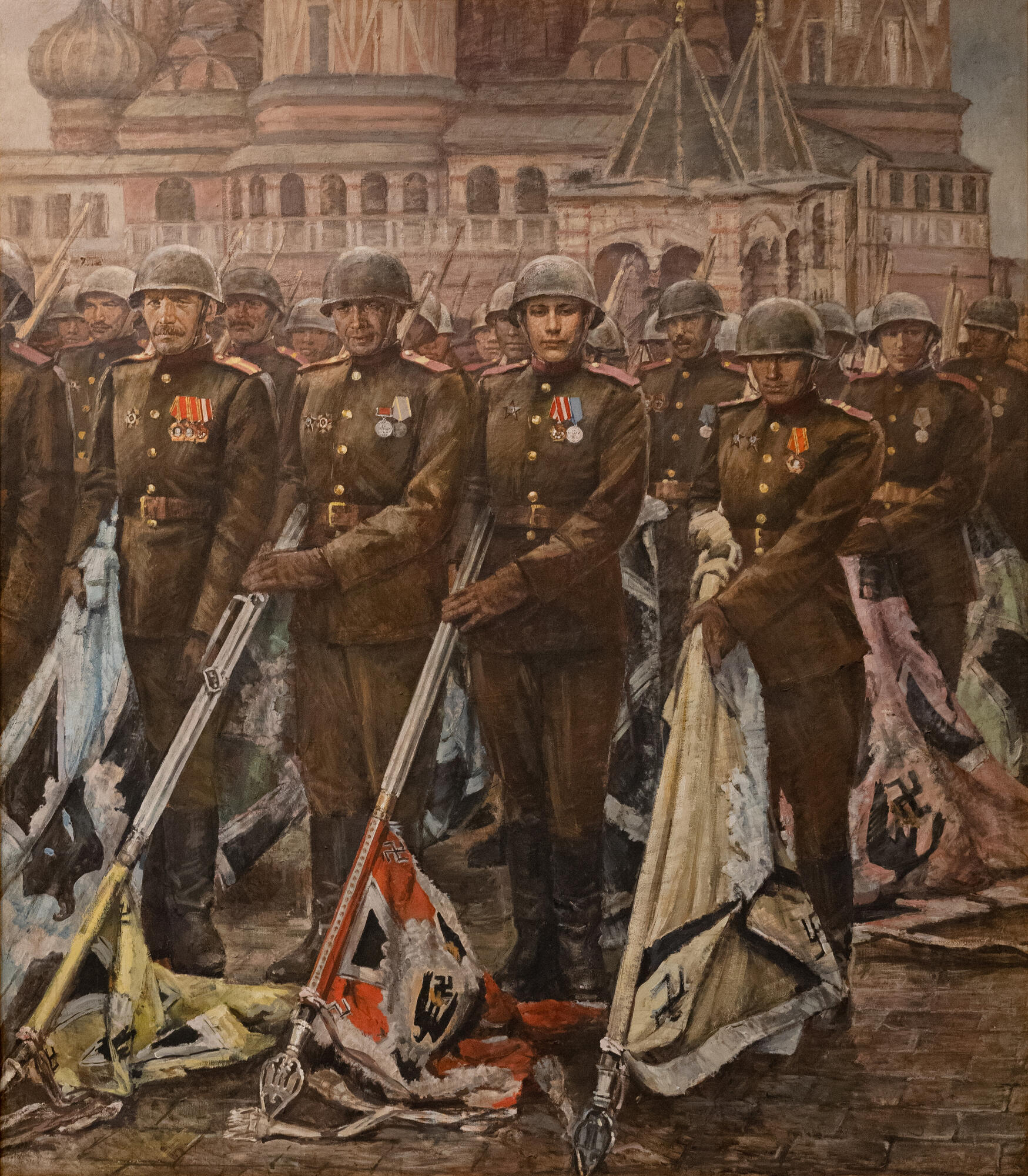“The Victors” is a painting that holds a special place in the exhibition “The Feat of the Army”. The talented artist Konstantin Antonov depicted the Moscow Victory Parade of 1945 — the ceremony that symbolized the long-expected end of the Great Patriotic War.
On June 24, 1945, over forty thousand soldiers marched across Red Square to celebrate the victory over Nazi Germany. The painting depicts the most emotional episode of the parade. The lowered Nazi standards are carried to the Mausoleum to the sound of beating drums. To demonstrate the disdain of Soviet soldiers for the Nazi standards and their unwillingness to touch the standards with bare hands, the dress uniform included a new special element — the gloves.
Joseph Stalin made the decision to organize a parade soon after the victory in the Great Patriotic War. Each detail was carefully thought-through. The Victory Banner was brought from Berlin to Moscow, along with captured enemy standards. Only the soldiers who had demonstrated great heroism and courage in action were allowed to participate in the parade. Their physical characteristics, including height and weight, were also important.
The parade was attended by all prominent figures of the Soviet Union and inspected by Marshal Georgy Zhukov. Marshal Konstantin Rokossovsky commanded the Victory Parade. For the parade to be held on time, a wide range of tasks had to be accomplished in a very short period. Clothes factories worked actively on supplying dress uniforms. The employees of the Bolshoi Theater workshop made dozens of standards and hundreds of decoration ribbons. Despite the great amount of work, all assignments were completed.
The Victory Parade began at 10 a.m. sharp. Even the bad weather did not spoil the event. The soldiers marched in the rain for two hours. Marshal Georgy Zhukov rode onto Red Square on a white stallion and congratulated the frontline soldiers on the Great Victory. The ceremonial march was conducted to the sound of beating drums. At the end of the parade, German standards were tossed down to the walls of the Mausoleum. This symbolized the triumph of the Soviet people who had managed to defeat the invaders.
On June 24, 1945, over forty thousand soldiers marched across Red Square to celebrate the victory over Nazi Germany. The painting depicts the most emotional episode of the parade. The lowered Nazi standards are carried to the Mausoleum to the sound of beating drums. To demonstrate the disdain of Soviet soldiers for the Nazi standards and their unwillingness to touch the standards with bare hands, the dress uniform included a new special element — the gloves.
Joseph Stalin made the decision to organize a parade soon after the victory in the Great Patriotic War. Each detail was carefully thought-through. The Victory Banner was brought from Berlin to Moscow, along with captured enemy standards. Only the soldiers who had demonstrated great heroism and courage in action were allowed to participate in the parade. Their physical characteristics, including height and weight, were also important.
The parade was attended by all prominent figures of the Soviet Union and inspected by Marshal Georgy Zhukov. Marshal Konstantin Rokossovsky commanded the Victory Parade. For the parade to be held on time, a wide range of tasks had to be accomplished in a very short period. Clothes factories worked actively on supplying dress uniforms. The employees of the Bolshoi Theater workshop made dozens of standards and hundreds of decoration ribbons. Despite the great amount of work, all assignments were completed.
The Victory Parade began at 10 a.m. sharp. Even the bad weather did not spoil the event. The soldiers marched in the rain for two hours. Marshal Georgy Zhukov rode onto Red Square on a white stallion and congratulated the frontline soldiers on the Great Victory. The ceremonial march was conducted to the sound of beating drums. At the end of the parade, German standards were tossed down to the walls of the Mausoleum. This symbolized the triumph of the Soviet people who had managed to defeat the invaders.



